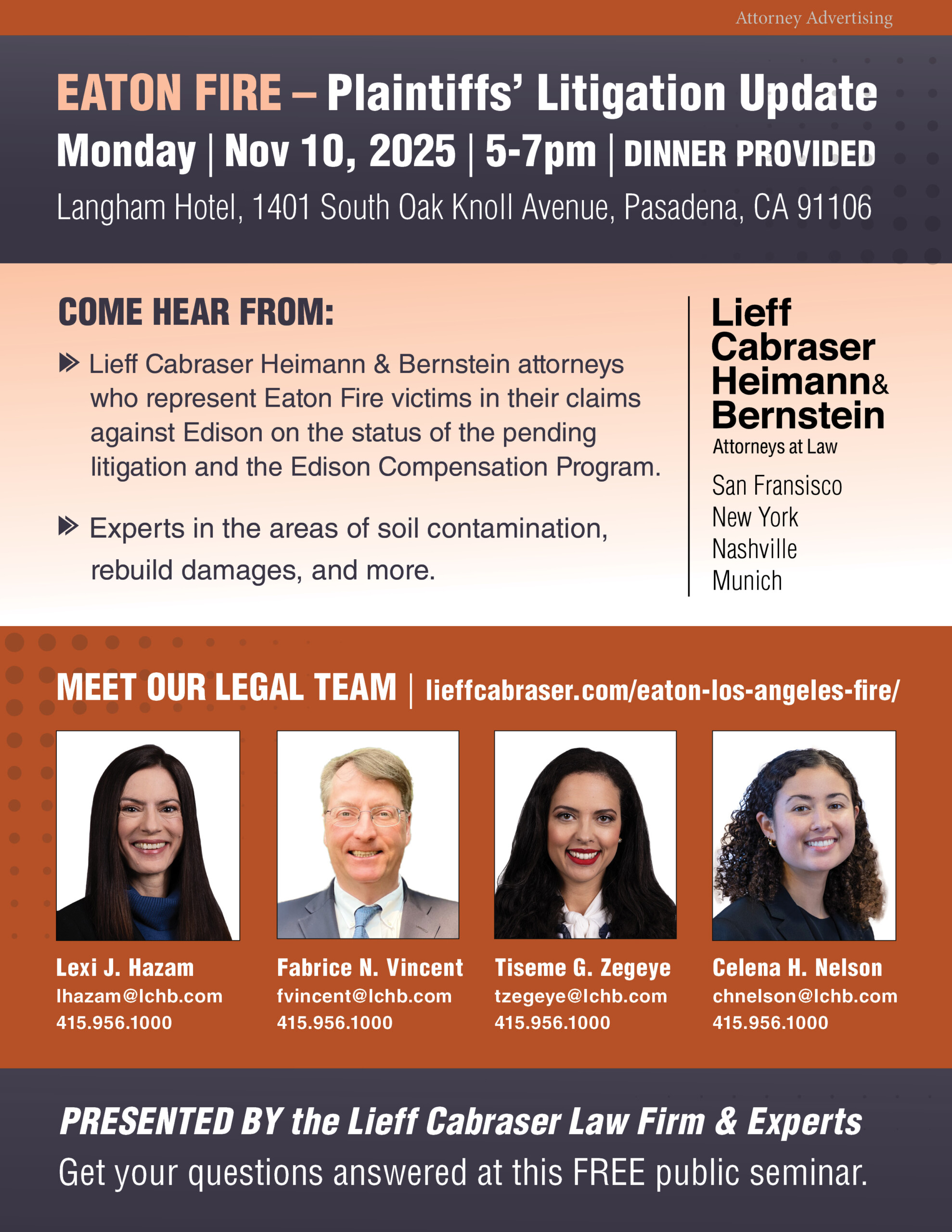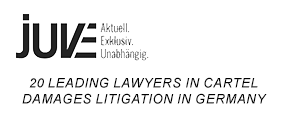2025 Los Angeles Wildfires – Eaton
Lieff Cabraser Heimann & Bernstein represents Eaton Fire victims in their claims against Southern California Edison for its role in the Eaton Fire. You can read a copy of our first filed complaint or read a copy of the press release.
If you or a loved one suffered losses in the Eaton Fire, we can help you navigate insurance claims and potential legal action against Southern California Edison. To talk to a lawyer today, use the form below or call us at 1 800 541-7358.
July 2025: Please note that USC is offering free Altadena soil lead testing, visit publicexchange.usc.edu/la-wildfire-soil-testing.
Our thoughts and our hearts go out to our friends, family members, colleagues and all those affected by the devastating January 2025 wildfires in Los Angeles.
The Lieff Cabraser law firm has successfully litigated wildfire and other environmental cases on behalf of devastated California homeowners and businesses for over 30 years. We represent clients in their potential claims against Southern California Edison, the electrical utility for Los Angeles, for its role in the Eaton Fire.
Litigation Updates
Judge Seigle of Los Angeles Superior Court’s Complex Division continues to press the case forward. Following two August case-management hearings, the Court has set January 25, 2027 for the first bellwether trial, with all pre-trial filings due January 4, 2027. Bellwether cases—covering total home loss, smoke/ash, business losses, wrongful death, personal injury, and tenant claims—will be selected in spring 2026, and the Court has directed that several “preference” plaintiffs (elderly or medically fragile) be included so their matters are heard promptly.
Discovery is advancing on multiple fronts. Joint inspections and sophisticated CT scans of the removed transmission towers continue to show arcing damage that supports plaintiffs’ cause-and-origin theory; no contrary evidence has surfaced. At the same time, Southern California Edison (“SCE”) is pursuing what it calls a “spread theory,” arguing that additional entities share responsibility. The Court has set a firm deadline of January 16, 2026 for SCE to add any cross-defendants, preventing delay.
SCE has signaled it will roll out a voluntary compensation program this fall. While we will review those terms carefully, SCE’s ongoing refusal in court to accept full liability suggests the program could undervalue many claims. For now, we remain focused on preparing every case for trial and maximizing recoveries through the litigation process.
On September 4, 2025, federal prosecutors filed a civil lawsuit against SCE over its alleged role in the Eaton fire. The complaint alleges that the fire was ignited by faulty power infrastructure owned, maintained, and operated by Edison. Acting U.S. Attorney Bill Essayli stated, “The lawsuits filed today allege a troubling pattern of negligence resulting in death, destruction, and tens of millions of federal taxpayer dollars spent to clean up one utility company’s mistakes. We hope that today’s filings are the first step in causing the beginnings of a culture change at Southern California Edison, one that will make it a responsible, conscientious company that helps — not harms — our community.” Essayli further emphasized, “We believe that the evidence is clear that Edison is at fault. The reason not to wait is because fire season is coming up again. We want Edison to change the way it does business. It does not maintain its infrastructure in a way to prevent fires. We do not want another fire igniting.”
Resources
We recognize that many families are concerned about the health impacts of wildfires. For those seeking information and support, we recommend the following resources:
- Los Angeles Fire Health – Current Study: Ongoing research into the long-term health effects of Los Angeles wildfires, including free webinars on topics such as smoke exposure and health
- LA Fire Health Resources Bank
- Long-Term Eaton Fires Study Info
- Wildfires in LA: Smoke, Exposures, and Your Health Webinar
- LA Times on Health Risks in LA Fires Aftermath: LA Times podcast discusses ongoing research efforts and may be of interest to those looking to learn more about the evolving understanding of wildfire health impacts
- Researchers Assessing Long Term LA Wildfire Health Risks: Scientists are actively assessing the long-term health risks associated with wildfire exposure, with new studies and reviews available for those interested in the latest findings
- Long-term Health Effects of Wildfire Exposure: Investigation information from Science Direct
- UC Davis Air Quality Info Site: Information on how wildfire smoke and ash can impact your health and steps you can take to protect yourself
We are here to support our clients not only in the legal process but also in navigating the broader challenges posed by wildfire events. Please reach out if you have questions or need further information.
Eaton Fire
The Eaton Fire, in east Los Angeles, started on January 7, 2025, tore through the diverse community of Altadena, and burned for three weeks until final containment was reached. The Fire burned over 14,000 acres and CalFire estimates over 10,000 structures have been damaged or destroyed, including 4,356 single-family homes, 77 multi-family buildings, and 123 commercial buildings. Tragically, the Eaton Fire is also now one of California’s deadliest fires, with 18 people losing their lives, including some elderly and disabled residents who were unable to escape (and their family members who would not leave their sides).
Talk to us
Southern California Fire Cases / Thomas Wildfire & Mudslide Litigation
Lieff Cabraser attorney Lexi Hazam serves as Co-Lead Counsel for Individual Plaintiffs in JCCP litigation involving thousands of Plaintiffs against Southern California Edison over the role of the utility’s equipment in starting the devastating Thomas Fire that destroyed over a thousand homes in Southern California in December 2017, and the resulting mudslides in Montecito that destroyed additional homes and killed 23 people. Before multiplaintiff bellwether trials were to occur in 2021, the litigation entered into a settlement protocol, which has resolved over 1,600 cases to date. Together with the individual plaintiffs in the Woolsey Fire, below, these plaintiffs have recovered well over $1 billion to date.
Woolsey Fire Cases
Lieff Cabraser counsel Lexi Hazam serves as Co-Lead Counsel for Individual Plaintiffs in the coordinated Woolsey Fire Case JCCP litigation against Southern California Edison relating to the devastating 2018 fire that burned more than 1,600 homes and 96,000 acres in Los Angeles and Ventura Counties. In 2022, the litigation entered into a settlement protocol alongside the Thomas Fire cases, which has resolved over 2,000 Woolsey cases to date, with a recovery of over $1 billion.
Northern California Fire Cases / 2017 North Bay Fires / 2018 Camp Fire
Lieff Cabraser lawyers Elizabeth Cabraser and Lexi Hazam served on the Individual Plaintiffs’ Executive Committee in the consolidated lawsuits against PG&E over 2017 North Bay fire losses. After PG&E and its parent filed for bankruptcy, the appointed Torts Claimants’ Committee (including our firm, with a client who lost her father in the Camp Fire) represented persons with tort claims, largely wildfire victims, in the bankruptcy, helping to negotiate a settlement of $13.5 billion to compensate fire victims for their losses. Elizabeth Cabraser also served on the Trust Oversight Committee that has monitored and assisted the Trustee in administering the gargantuan and complex claims process.
Maui Fire Litigation
In collaboration with local Hawai‘i attorneys, our firm represents Maui residents and businesses affected by the devastating August 2023 Lahaina Fire. The deadliest fire in Hawai‘i’s history, it consumed thousands of acres and destroyed over 2,200 structures, most of them residential, causing widespread losses. Investigations indicate that equipment owned by Hawaiian Electric Company (HECO) sparked the fire, with utility lines contacting vegetation during high winds. Despite Red Flag conditions, HECO failed to implement a power safety shut-off program, contributing to this catastrophic event. There is a proposed global settlement for the Fire of over $4 billion pending.
Learn About Our Team
About Elizabeth J. Cabraser
 Possessing unparalleled expertise in complex civil litigation, Elizabeth has served as court-appointed lead, co-lead, or class counsel in scores of federal multi-district and state coordinated proceedings, including multiple California fire cases, multi-state tobacco, the Exxon Valdez disaster, Breast Implants, Fen-Phen (Diet Drugs), Vioxx, Toyota sudden acceleration, numerous securities/investment fraud cases, and historic Holocaust litigation.
Possessing unparalleled expertise in complex civil litigation, Elizabeth has served as court-appointed lead, co-lead, or class counsel in scores of federal multi-district and state coordinated proceedings, including multiple California fire cases, multi-state tobacco, the Exxon Valdez disaster, Breast Implants, Fen-Phen (Diet Drugs), Vioxx, Toyota sudden acceleration, numerous securities/investment fraud cases, and historic Holocaust litigation.
About Lexi J. Hazam
 The Chair of Lieff Cabraser’s Personal Injury/Mass Tort practice group, Lexi J. Hazam represents clients in mass tort cases and environmental class actions, as well as whistleblower/false claims act actions. Lexi is also Court-appointed Co-Lead Counsel for the thousands of Individual Plaintiffs in the Thomas Fire (No. 4965) and Woolsey Fire JCCPs (No. 5000), litigations against Southern California Edison arising from the colossal wildfires and ensuing mudslide Edison’s faulty equipment caused in recent years.
The Chair of Lieff Cabraser’s Personal Injury/Mass Tort practice group, Lexi J. Hazam represents clients in mass tort cases and environmental class actions, as well as whistleblower/false claims act actions. Lexi is also Court-appointed Co-Lead Counsel for the thousands of Individual Plaintiffs in the Thomas Fire (No. 4965) and Woolsey Fire JCCPs (No. 5000), litigations against Southern California Edison arising from the colossal wildfires and ensuing mudslide Edison’s faulty equipment caused in recent years.
About Fabrice Vincent
 Fabrice Vincent is a tireless and principled advocate for the injured and the families of loved ones who died in personal injury and wrongful death cases. Fabrice’s cases include various California fire cases, JUUL vaping injury claims, baby formula injury and death claims, hair relaxer cancer claims, aviation accidents, auto and recreational vehicle accidents, and faulty medical devices.
Fabrice Vincent is a tireless and principled advocate for the injured and the families of loved ones who died in personal injury and wrongful death cases. Fabrice’s cases include various California fire cases, JUUL vaping injury claims, baby formula injury and death claims, hair relaxer cancer claims, aviation accidents, auto and recreational vehicle accidents, and faulty medical devices.
About Tiseme Zegeye
 A partner in Lieff Cabraser’s San Francisco office and a five-year Best Lawyers “Ones to Watch” awardee as well as a two-time winner of Lawdragon’s “Lawdragon 500 X – The Next Generation” award, Tiseme Zegeye specializes in environmental justice cases, women’s health, and civil rights cases, including representing women and families in fertility and gynecologic cancer matters and representing the injured in water contamination and wildfire cases.
A partner in Lieff Cabraser’s San Francisco office and a five-year Best Lawyers “Ones to Watch” awardee as well as a two-time winner of Lawdragon’s “Lawdragon 500 X – The Next Generation” award, Tiseme Zegeye specializes in environmental justice cases, women’s health, and civil rights cases, including representing women and families in fertility and gynecologic cancer matters and representing the injured in water contamination and wildfire cases.
About Patrick Andrews
 Patrick Andrews is a Partner in Lieff Cabraser’s San Francisco office with over six years of experience in toxic torts, environmental, and pharmaceutical complex civil litigation. He most recently was a member of the firm’s litigation team that successfully obtained $95 million in settlements on behalf of fishers, property owners, and business affected by the 2021 Orange County oil spill.
Patrick Andrews is a Partner in Lieff Cabraser’s San Francisco office with over six years of experience in toxic torts, environmental, and pharmaceutical complex civil litigation. He most recently was a member of the firm’s litigation team that successfully obtained $95 million in settlements on behalf of fishers, property owners, and business affected by the 2021 Orange County oil spill.
About Nick Lee
 Nick W. Lee is an associate in Lieff Cabraser’s San Francisco office. He works in the firm’s mass torts, consumer fraud, and antitrust practice groups.
Nick W. Lee is an associate in Lieff Cabraser’s San Francisco office. He works in the firm’s mass torts, consumer fraud, and antitrust practice groups.
About Celena Nelson
 An associate in Lieff Cabraser’s San Francisco office, Celena Nelson’s recent mass tort work has included the Toyota emissions fraud cases.
An associate in Lieff Cabraser’s San Francisco office, Celena Nelson’s recent mass tort work has included the Toyota emissions fraud cases.
Resources
- Los Angeles Fire Health – Current Study
- LA Fire Health Resources Bank
- Long-Term Eaton Fires Study Info
- Wildfires in LA: Smoke, Exposures, and Your Health Webinar
- LA Times Report on Toxic Metals in LA Fire Ruins
- Researchers Assessing Long Term LA Wildfire Health Risks
- Long-term Health Effects of Wildfire Exposure
- UC Davis Air Quality Info Site
Related News
- September 19, 2025
A new study shows wildfires are causing more than 40,000 premature deaths per year — and that rising temperatures will lead to even more
The Washington Post - September 15, 2025
Eaton fire contaminated Altadena with lead. It’s lingering even after cleanup, final county report finds
Los Angeles Times - June 1, 2025
Wildfire destroyed a historically Black town. These artists won’t let its legacy disappear
The Guardian - April 23, 2025
Artist Eddie Rodolfo Aparicio, affected by the Eaton fire, traces memories and time
Los Angeles Times - April 16, 2025
911 logs show more than a dozen calls from burning west Altadena before evacuations ordered
Los Angeles Times - April 16, 2025
The Impact of the L.A. Fires Was Felt Far From the Burn Zone, Poll Shows
The New York Times - April 11, 2025
Edison says dormant powerline is a leading theory for cause of Eaton fire
Los Angeles Times - April 10, 2025
Secret changes Edison imposed after Eaton fire remain shrouded in mystery
Los Angeles Times - April 1, 2025
Activity swirls around Edison towers in search for cause of Eaton fire
Los Angeles Times
- March 26, 2025
When the Helpers Need Help – Opinion
JewishInsider - March 24, 2025
‘That was my home’: faith communities without worship spaces after LA fires
The Guardian - March 19, 2025
Power lines suspected of starting Eaton fire were overdue for ‘ignition risk’ repairs
Los Angeles Times - March 18, 2025
Edison’s Power Lines Were Under Strain 14 Hours Before Eaton Fire
New York Times - March 5, 2025
L.A. County sues Southern California Edison over Eaton fire
Los Angeles Times - March 3, 2025
Their homes remain standing, but these L.A. wildfire victims still might lose them
NBC News - February 28, 2025
8 Kids on What They Saved From the L.A. Fires
New York Times Magazine - February 23, 2025
‘An ode to Altadena’: LA arts community bands together to support fire-ravaged neighborhood
The Guardian - January 29, 2025
New Data Shows Major Electrical Disruption Ahead of Eaton Fire
New York Times - January 28, 2025
Power lines over Eaton Canyon saw surge in current before fire, Edison reveals
Los Angeles Times - January 26, 2025
Flashes Then Flames: New Video of Eaton Fire Raises More Questions for Power Company
New York Times - January 22, 2025
In western Altadena, where 17 wildfire deaths were reported, residents say evacuation alerts came late or not at all
CNN - January 20, 2025
Their Homes Are Intact, but the Fire Damage Inside Is Unbearable
New York Times - January 16, 2025
After the Eaton Fire, will Altadena’s thriving Black and Latino communities be able to rebuild?
San Francisco Chronicle - January 15, 2025
Some attorneys suing over fires are victims themselves
Daily Journal - January 14, 2025
Shattered in the Fire: A Historic Black Haven
New York Times - January 13, 2025
SoCal Edison blamed in a lawsuit for starting one of the Los Angeles fires
CNN - January 10, 2025
Did power lines help start the L.A. fires? What we know
Washington Post - January 10, 2025
L.A. Utilities’ Decisions to Keep Power on Are Scrutinized
New York Times - January 10, 2025
Faults on power grid skyrocketed in hours before L.A. firestorm began
Los Angeles Times - January 9, 2025
How did the L.A. fires start? Here’s what we know so far
San Francisco Chronicle - January 9, 2025
How to Help Victims of the Southern California Wildfiress
New York Times - January 9, 2025
A technology company says its sensors signaled stress on power lines near the start of the wildfires
New York Times - January 9, 2025
Here’s where the Palisades and Eaton Fire began
CNN












